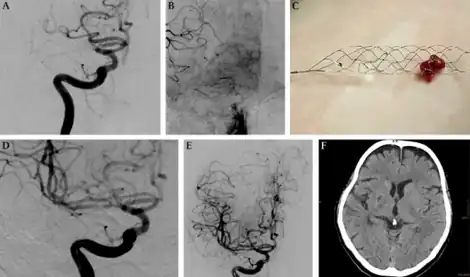Thrombectomy
| Thrombectomy | |
|---|---|
 | |
| Mechanical thrombectomy using a Solitaire stent-a)Injection of internal carotid artery shows embolic occlusion b)leptomeningeal collaterals visualized c)solitaire stent loaded with thrombus d,e)DSA with injection of right ICA f) 22 months after there is a small post-ischemic scar | |
| Frequency | Lua error in Module:PrevalenceData at line 5: attempt to index field 'wikibase' (a nil value). |
Mechanical thrombectomy, or simply thrombectomy, is the interventional procedure of removing a blood clot (thrombus) from a blood vessel. It is commonly performed in the cerebral arteries (interventional neuroradiology). The effectiveness of thrombectomy was confirmed in several randomised clinical trials conducted at University at Buffalo and elsewhere by a team of researchers including Elad Levy.[1]
Applications in brain
Ischemic stroke represents the fifth most common cause of death in the western world and the number one cause of long-term disability. Until recent times, systemic intravenous fibrinolysis was the only evidence-based therapy for patients with acute onset of stroke due to large vessel occlusion.
In 2015, the results of five trials from different countries were published in the New England Journal of Medicine, demonstrating the safety and efficacy of mechanical thrombectomy with stent-retrievers in improving outcomes and reducing mortality for patients who present within six hours from their time last known well. It is now a widespread procedure performed in most primary, thrombectomy capable, or comprehensive stroke centers across the globe.
In 2018 the DAWN and DEFUSE-3 trials were published. These trials showed that mechanical thrombectomy is a safe and effective treatment for individuals who have an acute ischemic stroke out to 24 hours of symptom onset.[2][3]
Stent-retriever thrombectomy
The procedure can be performed with general anesthesia or under conscious sedation in an angiographic room. A system of coaxial catheters is pushed inside the arterial circulation, usually through a percutaneous access to the right femoral artery. A microcatheter is finally positioned beyond the occluded segment and a stent-retriever is deployed to catch the thrombus; finally, the stent is pulled out from the artery, usually under continuous aspiration in the larger catheters.
Direct aspiration
A different technique for mechanical thrombectomy in the brain is direct aspiration. It is performed by pushing a large soft aspiration catheter into the occluded vessel and applying direct aspiration to retrieve the thrombus; it can be combined with the stent-retriever technique to achieve higher recanalization rates, but the complexity of the procedure increases.
Direct aspiration has not been studied as thoroughly as stent-retriever thrombectomy, but it is still widely performed because of its relative simplicity and low cost.
See also
References
- ↑ Saver, Jeffrey L.; Goyal, Mayank; Bonafe, Alain; Diener, Hans-Christoph; Levy, Elad I.; Pereira, Vitor M.; Albers, Gregory W.; Cognard, Christophe; Cohen, David J.; Hacke, Werner; Jansen, Olav; Jovin, Tudor G.; Mattle, Heinrich P.; Nogueira, Raul G.; Siddiqui, Adnan H.; Yavagal, Dileep R.; Baxter, Blaise W.; Devlin, Thomas G.; Lopes, Demetrius K.; Reddy, Vivek K.; du Mesnil de Rochemont, Richard; Singer, Oliver C.; Jahan, Reza (11 June 2015). "Stent-Retriever Thrombectomy after Intravenous t-PA vs. t-PA Alone in Stroke" (PDF). New England Journal of Medicine. 372 (24): 2285–2295. doi:10.1056/NEJMoa1415061. PMID 25882376. Archived (PDF) from the original on 30 January 2021. Retrieved 30 December 2021.
- ↑ Albers, Gregory W.; Marks, Michael P.; Kemp, Stephanie; Christensen, Soren; Tsai, Jenny P.; Ortega-Gutierrez, Santiago; McTaggart, Ryan A.; Torbey, Michel T.; Kim-Tenser, May; Leslie-Mazwi, Thabele; Sarraj, Amrou; Kasner, Scott E.; Ansari, Sameer A.; Yeatts, Sharon D.; Hamilton, Scott; Mlynash, Michael; Heit, Jeremy J.; Zaharchuk, Greg; Kim, Sun; Carrozzella, Janice; Palesch, Yuko Y.; Demchuk, Andrew M.; Bammer, Roland; Lavori, Philip W.; Broderick, Joseph P.; Lansberg, Maarten G. (22 February 2018). "Thrombectomy for Stroke at 6 to 16 Hours with Selection by Perfusion Imaging". New England Journal of Medicine. 378 (8): 708–718. doi:10.1056/NEJMoa1713973. PMC 6590673. PMID 29364767.
- ↑ Nogueira, Raul G.; Jadhav, Ashutosh P.; Haussen, Diogo C.; Bonafe, Alain; Budzik, Ronald F.; Bhuva, Parita; Yavagal, Dileep R.; Ribo, Marc; Cognard, Christophe; Hanel, Ricardo A.; Sila, Cathy A.; Hassan, Ameer E.; Millan, Monica; Levy, Elad I.; Mitchell, Peter; Chen, Michael; English, Joey D.; Shah, Qaisar A.; Silver, Frank L.; Pereira, Vitor M.; Mehta, Brijesh P.; Baxter, Blaise W.; Abraham, Michael G.; Cardona, Pedro; Veznedaroglu, Erol; Hellinger, Frank R.; Feng, Lei; Kirmani, Jawad F.; Lopes, Demetrius K.; Jankowitz, Brian T.; Frankel, Michael R.; Costalat, Vincent; Vora, Nirav A.; Yoo, Albert J.; Malik, Amer M.; Furlan, Anthony J.; Rubiera, Marta; Aghaebrahim, Amin; Olivot, Jean-Marc; Tekle, Wondwossen G.; Shields, Ryan; Graves, Todd; Lewis, Roger J.; Smith, Wade S.; Liebeskind, David S.; Saver, Jeffrey L.; Jovin, Tudor G. (4 January 2018). "Thrombectomy 6 to 24 Hours after Stroke with a Mismatch between Deficit and Infarct". New England Journal of Medicine. 378 (1): 11–21. doi:10.1056/NEJMoa1706442. PMID 29129157.
External links
- Archived 2021-01-26 at the Wayback Machine
- Endovascular clot retrieval (ECR) | Radiology Reference Article | Radiopaedia.org Archived 2020-05-10 at the Wayback Machine